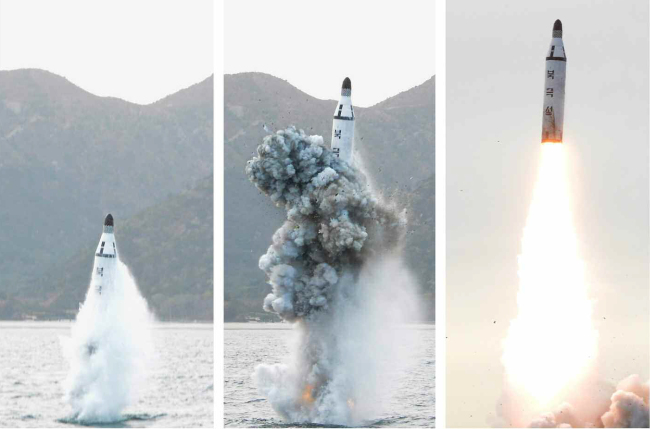U.N. condemns N.K. SLBM launch
Experts say Pyongyang’s SLBM presents threat to Seoul-Washington alliance
By Yoon Min-sikPublished : April 25, 2016 - 16:45
The U.N. Security Council on Sunday condemned North Korea’s recent submarine-launched ballistic missile test, which experts say demonstrated some level of success.
In a press statement, the council said the launch was “yet another serious violation” of the UNSC resolution which bans the communist country from any ballistic missile or nuclear programs.
Pyongyang claimed Saturday’s SLBM to be a success, although the South Korean military downplayed it, citing that it flew only 30 kilometers. The minimum known range for the country’s KN-11 SLBM is 300 kilometers.
In a press statement, the council said the launch was “yet another serious violation” of the UNSC resolution which bans the communist country from any ballistic missile or nuclear programs.
Pyongyang claimed Saturday’s SLBM to be a success, although the South Korean military downplayed it, citing that it flew only 30 kilometers. The minimum known range for the country’s KN-11 SLBM is 300 kilometers.

“Members of the Security Council emphasized that the DPRK’s (North Korea’s) development and testing of new ballistic missile capabilities, even if launches are failures, is clearly prohibited by these resolutions,” the UNSC said.
The council expressed concern about how the missile activities would lead to rising tension in the region, and vowed that its members will continue to closely monitor the situation and take “further significant measures in line with the council’s previously expressed determination.”
Inter-Korea tensions have been riding high on the North’s nuclear tests, long-range rocket launch and its leader Kim Jong-un’s demonstration of the country’s arsenal.
“The UNSC statement is significant in that it views the missile activities as contributing to the North’s development of nuclear weapons delivery systems, subsequently leading to rising tension in the (Northeast Asia) region. ... UNSC members, including China and Russia, have severely warned North Korea on its continued acts of provocation,” said Seoul’s Foreign Ministry on Monday.
It stressed that China, Pyongyang’s sole major trading partner, has played a key role in adopting the statement.
Saturday’s launch, while far from Kim’s boastful claims of “complete success,” illustrated some progress that left observers on edge.
The most notable aspect was that it seems to have been launched from a submarine, albeit at a much shallower depth than deemed significant. It also demonstrated Pyongyang’s ability to “cold launch,” which refers to a missile being expelled and then igniting midair, considered crucial in submarine launches.
While military officials had initially labeled it “a failure” for its very short flight, some officials said it was “half successful,” as the ejection of the projectile itself at the very least seemed to have succeeded.
But aside from the ejection, the missile never entered its normal trajectory to be considered a successful launch. In addition, the 2,000-ton Sinpo-class submarine that it was launched from is considered too small to be used for firing a ballistic missile.
Most currently active ballistic missile submarines -- such as China’s Jin-class, U.S.’s Ohio-class, U.K.’s Vanguard class to Russia’s Borei class -- exceed 10,000 tons. Even the smaller Xia-class from China is over three times as large as the Sinpo-class.
As a platform, a smaller submarine is known to seriously hinder the successful ejection of the projectile, due to the backward momentum of the launch.
In addition, the merit of the SLBM is that it is difficult to detect -- usually fired from 50 meters underwater -- but the depths at which the North Korean SLBM was launched is presumed to be around 10-15 meters, which makes it susceptible to detection.
But some experts said that the North’s limitations do not imply that its SLBMs are not a threat.
Park Hwee-rhak, chief of Kookmin University’s graduate school of politics and leadership, pointed out that Saturday’s test could be considered a success if Pyongyang’s goal was to simply eject the missile from underwater and fly it briefly.
Although South Korea’s Defense Ministry said the SLBM will take at least 3-4 year to be deployed, though a concentrated effort could shorten the period significantly.
Park said the SLBM presents a threat to the Seoul-Washington alliance.
“The SLBM could potentially enable the North to sneak in on the U.S. for a nuclear strike, in which case Pyongyang can threaten a nuclear attack on any American city, forcing the U.S. to hesitate in its military support for South Korea,” he said. “Would the U.S. push ahead with a large-scale counterattack against North Korea’s nuclear attack, while submitting to a nuclear missile attack on Seattle?”
It is known that the North’s goal is to deploy 3,000-ton submarines, along with SLBMs that can strike targets 2,000 kilometers away. This would present a threat to the U.S.
The 3,000-ton submarine would be able to conduct a launch from deeper in the ocean while carrying multiple missiles. The Sinpo submarines are known to carry only one missile at a time, putting it at a strategic disadvantage.
Military experts presume that the current KN-11 missile -- believed to be using more stable solid-fuel rocket engine -- already has the potential to fly 2,000 kilometers. But the reason it flew such a short distance during Saturday’s test still remains unclear.
With the North seemingly speeding up its SLBM programs, there are talks that South Korea should develop its own nuclear-powered submarines.
Defense Ministry Moon Sang-kyun said Monday that the military’s main strategy to counter the SLBM threats is the Kill Chain and Korea Air and Missile Defense preemptive strike -- to be set up by the early 2020s. He said there are no plans yet to build a nuclear-powered submarine. He added the ministry is open to such suggestions.
South Korea is expected to deploy 3,000-ton Jangbogo-3 submarines by early 2020. Yonhap News Agency reported Monday that the state-run Defense Acquisition Program Administration is planning a project to install six to 10 ballistic missile launchers on the vessels.
By Yoon Min-sik (minsikyoon@heraldcorp.com)
The council expressed concern about how the missile activities would lead to rising tension in the region, and vowed that its members will continue to closely monitor the situation and take “further significant measures in line with the council’s previously expressed determination.”
Inter-Korea tensions have been riding high on the North’s nuclear tests, long-range rocket launch and its leader Kim Jong-un’s demonstration of the country’s arsenal.
“The UNSC statement is significant in that it views the missile activities as contributing to the North’s development of nuclear weapons delivery systems, subsequently leading to rising tension in the (Northeast Asia) region. ... UNSC members, including China and Russia, have severely warned North Korea on its continued acts of provocation,” said Seoul’s Foreign Ministry on Monday.
It stressed that China, Pyongyang’s sole major trading partner, has played a key role in adopting the statement.
Saturday’s launch, while far from Kim’s boastful claims of “complete success,” illustrated some progress that left observers on edge.
The most notable aspect was that it seems to have been launched from a submarine, albeit at a much shallower depth than deemed significant. It also demonstrated Pyongyang’s ability to “cold launch,” which refers to a missile being expelled and then igniting midair, considered crucial in submarine launches.
While military officials had initially labeled it “a failure” for its very short flight, some officials said it was “half successful,” as the ejection of the projectile itself at the very least seemed to have succeeded.
But aside from the ejection, the missile never entered its normal trajectory to be considered a successful launch. In addition, the 2,000-ton Sinpo-class submarine that it was launched from is considered too small to be used for firing a ballistic missile.
Most currently active ballistic missile submarines -- such as China’s Jin-class, U.S.’s Ohio-class, U.K.’s Vanguard class to Russia’s Borei class -- exceed 10,000 tons. Even the smaller Xia-class from China is over three times as large as the Sinpo-class.
As a platform, a smaller submarine is known to seriously hinder the successful ejection of the projectile, due to the backward momentum of the launch.
In addition, the merit of the SLBM is that it is difficult to detect -- usually fired from 50 meters underwater -- but the depths at which the North Korean SLBM was launched is presumed to be around 10-15 meters, which makes it susceptible to detection.
But some experts said that the North’s limitations do not imply that its SLBMs are not a threat.
Park Hwee-rhak, chief of Kookmin University’s graduate school of politics and leadership, pointed out that Saturday’s test could be considered a success if Pyongyang’s goal was to simply eject the missile from underwater and fly it briefly.
Although South Korea’s Defense Ministry said the SLBM will take at least 3-4 year to be deployed, though a concentrated effort could shorten the period significantly.
Park said the SLBM presents a threat to the Seoul-Washington alliance.
“The SLBM could potentially enable the North to sneak in on the U.S. for a nuclear strike, in which case Pyongyang can threaten a nuclear attack on any American city, forcing the U.S. to hesitate in its military support for South Korea,” he said. “Would the U.S. push ahead with a large-scale counterattack against North Korea’s nuclear attack, while submitting to a nuclear missile attack on Seattle?”
It is known that the North’s goal is to deploy 3,000-ton submarines, along with SLBMs that can strike targets 2,000 kilometers away. This would present a threat to the U.S.
The 3,000-ton submarine would be able to conduct a launch from deeper in the ocean while carrying multiple missiles. The Sinpo submarines are known to carry only one missile at a time, putting it at a strategic disadvantage.
Military experts presume that the current KN-11 missile -- believed to be using more stable solid-fuel rocket engine -- already has the potential to fly 2,000 kilometers. But the reason it flew such a short distance during Saturday’s test still remains unclear.
With the North seemingly speeding up its SLBM programs, there are talks that South Korea should develop its own nuclear-powered submarines.
Defense Ministry Moon Sang-kyun said Monday that the military’s main strategy to counter the SLBM threats is the Kill Chain and Korea Air and Missile Defense preemptive strike -- to be set up by the early 2020s. He said there are no plans yet to build a nuclear-powered submarine. He added the ministry is open to such suggestions.
South Korea is expected to deploy 3,000-ton Jangbogo-3 submarines by early 2020. Yonhap News Agency reported Monday that the state-run Defense Acquisition Program Administration is planning a project to install six to 10 ballistic missile launchers on the vessels.
By Yoon Min-sik (minsikyoon@heraldcorp.com)






![[Grace Kao] Hybe vs. Ador: Inspiration, imitation and plagiarism](http://res.heraldm.com/phpwas/restmb_idxmake.php?idx=644&simg=/content/image/2024/04/28/20240428050220_0.jpg&u=)
![[Herald Interview] Mom’s Touch seeks to replicate success in Japan](http://res.heraldm.com/phpwas/restmb_idxmake.php?idx=644&simg=/content/image/2024/04/29/20240429050568_0.jpg&u=)


![[News Focus] Lee tells Yoon that he has governed without political dialogue](http://res.heraldm.com/phpwas/restmb_idxmake.php?idx=644&simg=/content/image/2024/04/29/20240429050696_0.jpg&u=20240429210658)









![[Today’s K-pop] Seventeen sets sales record with best-of album](http://res.heraldm.com/phpwas/restmb_idxmake.php?idx=642&simg=/content/image/2024/04/30/20240430050818_0.jpg&u=)